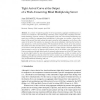Free Online Productivity Tools
i2Speak
i2Symbol
i2OCR
iTex2Img
iWeb2Print
iWeb2Shot
i2Type
iPdf2Split
iPdf2Merge
i2Bopomofo
i2Arabic
i2Style
i2Image
i2PDF
iLatex2Rtf
Sci2ools
INFORMATICALT
2010
2010
Tight Arrival Curve at the Output of a Work-Conserving Blind Multiplexing Server
Abstract. As a means of supporting quality of service guarantees, aggregate multiplexing has attracted a lot of attention in the networking community, since it requires less complexity than flowbased scheduling. However, contrary to what happens in the case of flow-based multiplexing, few results are available for aggregate-based multiplexing. In this paper, we consider a server multiplexer fed by several flows and analyze the impact caused by traffic aggregation on the flows at the output of the server. No restriction is imposed on the server multiplexer other than the fact that it must operate in a work-conserving fashion. We characterize the best arrival curves that constrain the number of bits that leave the server, in any time interval, for each individual flow. These curves can be used to obtain the delays suffered by packets in complex scenarios where multiplexers are interconnected, as well as to determine the maximum size of the buffers in the different servers. Previous...
| Added | 28 Jan 2011 |
| Updated | 28 Jan 2011 |
| Type | Journal |
| Year | 2010 |
| Where | INFORMATICALT |
| Authors | Juan Echagüe, Vicent Cholvi |
Comments (0)

